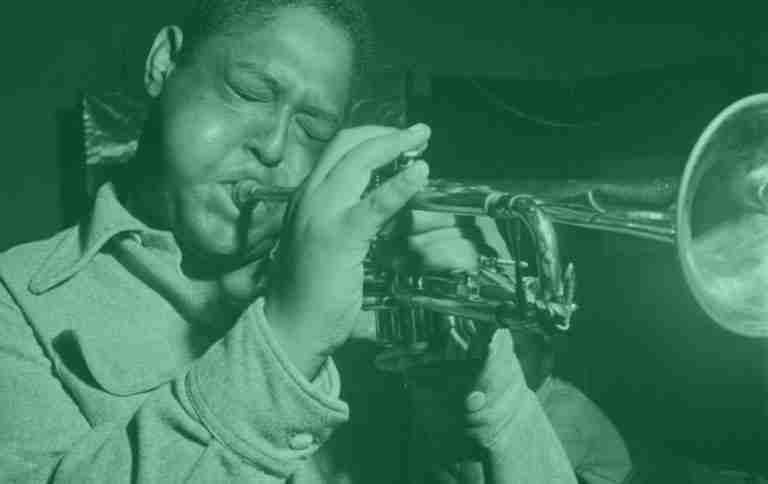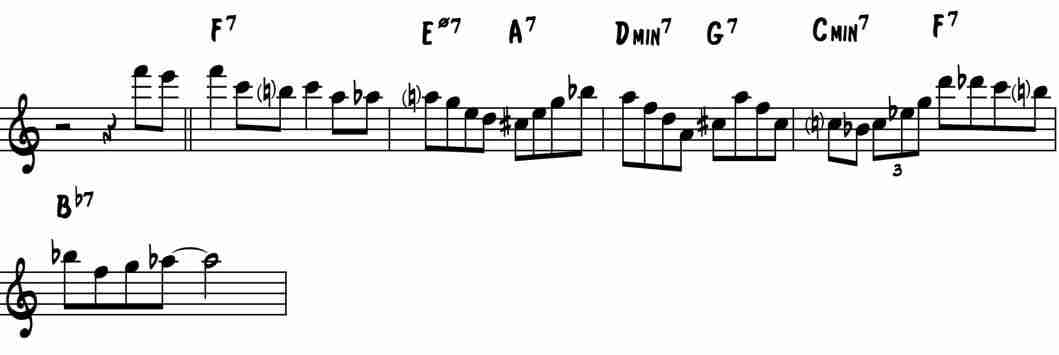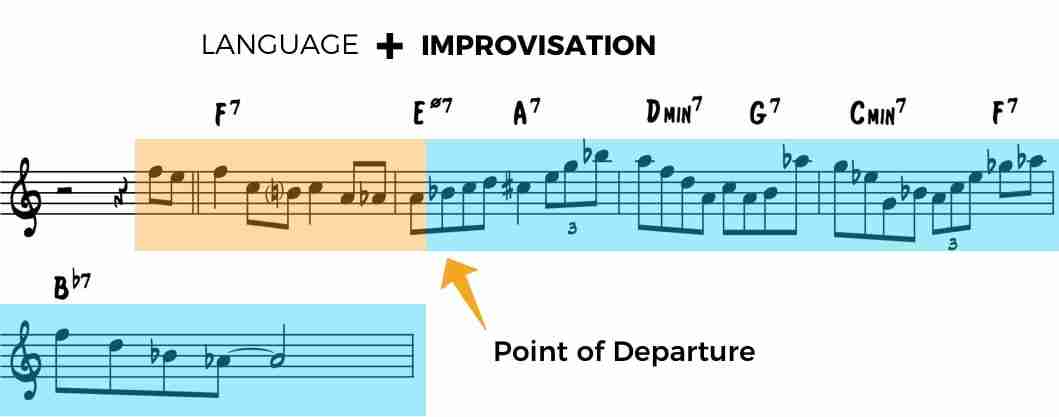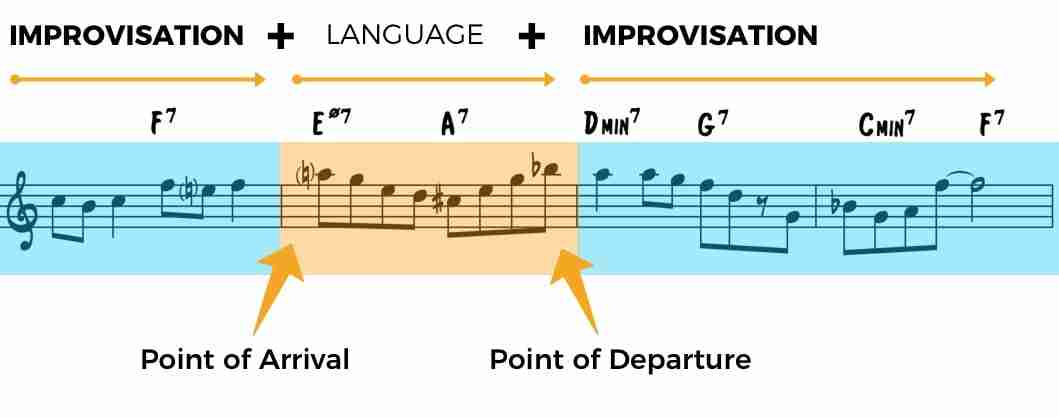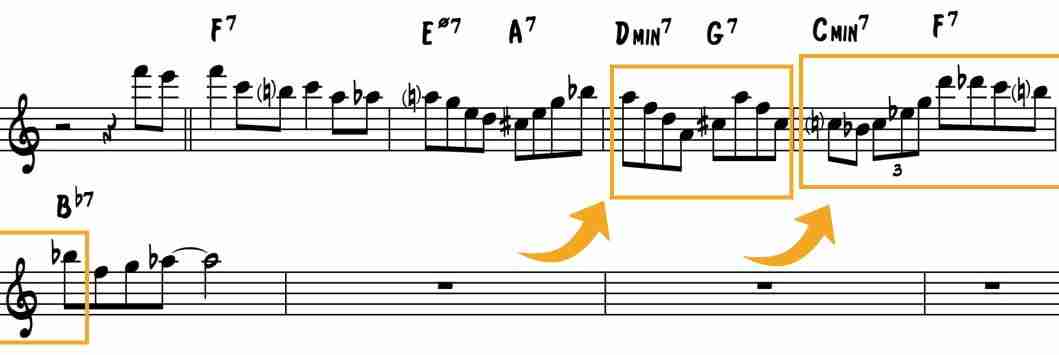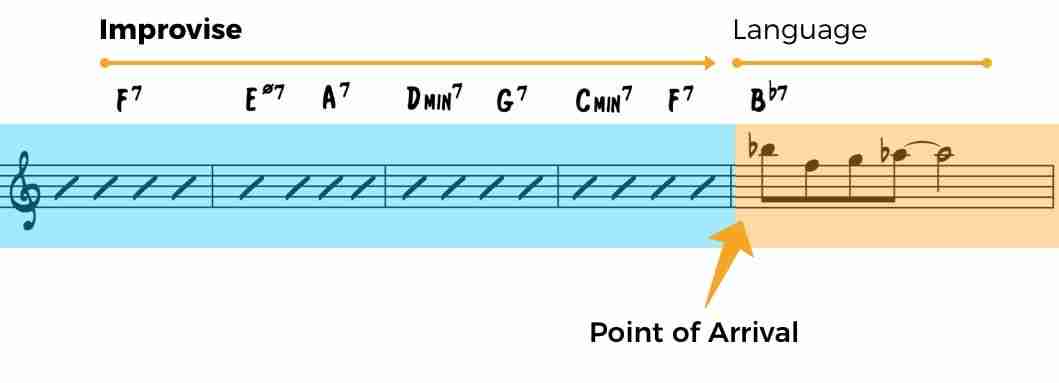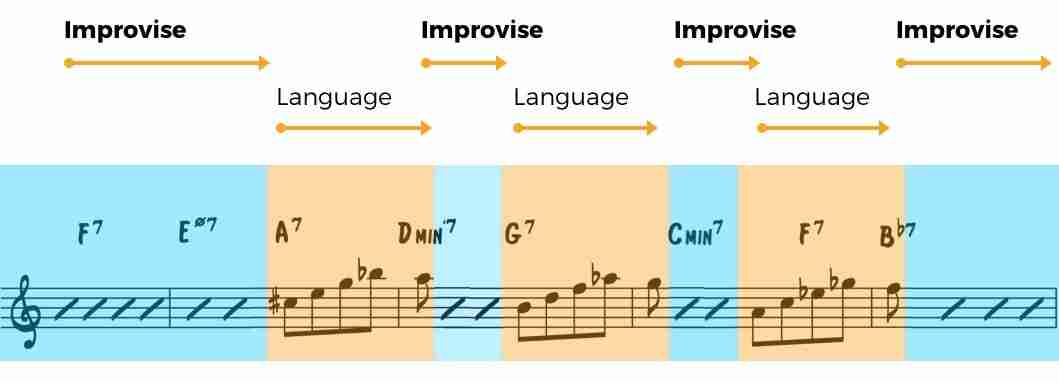After countless hours in the practice room, you’ve finally managed to transcribe one of your favorite players. You figured out a particular line that caught your ear, and now you’re learning it in all keys. You’re making great progress! But even after all this work, when you go to improvise you’re still playing the same old stuff. What happened? Where’s the language you’ve been working so hard on?
There’s nothing more frustrating than working on a line until you’re blue in the face, and not having it appear when you improvise.
Now, on rare occasion, language you transcribe does in fact get into your playing purely by osmosis. You go to improvise and it’s just there. But more often than not, the stuff you transcribe never quite makes it into your vocabulary, unless you take extra steps toward doing so.
Today, we’re going to explore some exercises you can practice to ensure that you’re not transcribing just to transcribe, but instead, adding to your reservoir of musical ideas: Your Jazz Vocabulary.
Why lines you transcribe never show up when you improvise
I know how it goes, all too well.
You put in hours, months, or even years…all this work, and for what?!?!?!
I thought I was just supposed to transcribe and then I’d have language at my disposal…
You learn a ton from transcribing. Sound. Feel. Articulation. Phrasing. Language. And a whole lot more…But, you do not magically acquire all that language and become fluent with it in all situations.
If it’s this flexibility you’re after, you have to first ask yourself a few questions…
How did you transcribe the line?
Are you transcribing with the recording and learning it note by note on your instrument, or just getting the notes?
There’s nothing wrong with transcribing a line or solo by getting one note at a time and writing it down, but, you will learn over 10X the amount if you learn the line by ear, with your instrument, without writing it down until you’ve completed it.
Why? Because forcing yourself to transcribe the line by ear and retain it without writing it down makes you repeat it over and over while you’re learning it. Each time you repeat the line, you’re ingraining it on a deeper level and paying more attention to the minute details within the music.
How well do you know the line?
Do you understand what’s going on in the line? Harmonically? Melodically? Rhythmically? Can you play the line in all keys without any effort?
You have to know the line inside and out. Backwards and forwards. If you have to think to use it, you won’t be able to improvise with it.
By understanding the concepts within the line and slowly practicing the line in all keys, you’ll begin to know the line on the high-level needed to use it without any effort.
What’s your approach to integrate new vocabulary?
What’s your process for taking language into your improvisational arsenal? Do you just transcribe and hope for the best? Do you learn lines in all keys? Do you have any process for this beyond that?
Chances are, you don’t have a process for integrating new vocabulary, which is one of the primary reasons the lines you work on don’t show up in your improvisation.
But not to worry. In this article, we’ll detail exactly what you can do to create and add to your process for integrating new jazz vocabulary.
The mental, aural, and physical prep work
Before a line becomes a part of your vocabulary, you need to have mastered it on a mental, aural, and physical level. If you go through this prep work, it will make it much easier for you to integrate the language into your jazz vocabulary.
The Mental Aspect:
- Do you understand the harmonic concept behind the line?
- Do you know all the chord-tones in the line and how they travel from one to the next?
- Can you “think through” the line in different keys?
Visualization plays a pivotal role in ingraining language. Make sure to visualize the language until it’s perfectly clear in your mind. If you can’t clearly visualize the line, it’s going to be very difficult to play it.
The Aural Aspect:
- Can you easily hear the line in all keys in your mind?
- Can you sing the line with accurate pitch?
- Can you hear the chords and chord-tone colors in your mind?
Hearing the intervals, chord-tones, and harmonic pieces, as well as singing the line is crucial to being able to improvise with it. For an in-depth guide to these skills and sounds, check out our course The Ear Training Method.
The Physical Aspect:
- Can you easily play the line in all keys?
- Did you practice the line at a slow tempo with a metronome?
- Can you play the line at a fast tempo?
Check out these articles for more ideas about how to master jazz language:
- Two Steps to Mastering Jazz Language
- 4 Steps to Freedom With Jazz Language
- 4 tricks to Playing Jazz Lines In All Keys
Once you have a line to the point that you can easily play and think about it without any effort, it’s time to start integrating it into your jazz vocabulary in a more direct way.
Building you jazz vocabulary through line integration exercises
A lot of people transcribe. And many people take language they like and put it in all keys, perhaps even getting it to a highly proficient level.
I remember practicing lines for hours and hours, and I still do this, as it helps with so many aspects of jazz improvisation…
But for a long time, when I’d go to improvise, the lines I practiced would never show up. For example, I’d work on a new line, then I’d go solo over a Blues or Rhythm Changes and instead of the new material showing up, the same old lines I’d played a million times would come out.
Then I realized…
You need a type of exercise that bridges the gap between the technical/mental challenges of a line AND actually using it in a real-life improvisational situation.
Line integration exercises are this bridge.
These type of exercises transition the language you’re woking on, into your usable jazz vocabulary.
These exercises accomplish this by combining a piece of language you’re trying to learn, with improvising.
Most people keep these two types of material separate. For instance, they might practice a line in all keys, and then after they’re done with that part of their practice, they’ll turn on a background track and improvise.
It never occurs to them that a better way to integrate the lines into their playing might be to combine the two…
By moving beyond playing a line in all keys, but not quite all the way to totally improvising, you learn how to move from one to the other.
This is how these exercises work: You specify exactly where you’re going to insert language and exactly where you’re going to improvise. There are 3 different places you can put a piece of language when you combine it with improvisation:
- At the beginning – Language + Improvisation
- In the middle – Improvisation + Language + Improvisation
- At the end – Improvisation + Language
When you use the piece of language at the beginning, it acts as point of departure for your improvised line. Used at the end, it’s a point of arrival, a place to aim for from your improvised line. And when inserted In the middle, it’s a point of departure and arrival.
If you’re a little confused right now, don’t worry. This will all make sense when we get into the exercises. But for now, think of creating one continuous line by combining a piece of jazz language with your own real-time improvisation. In this way, you learn how to directly integrate a piece of language with your current jazz vocabulary and improvisation mindset.
Let’s get into some exercises to see exactly how you’re going to practice this stuff…
Line Integration Exercises: Step-by-step
The concept behind these exercises is not difficult, but the actual practice of them is not so easy because you’re combining two very different things: a pre-defined bit of jazz language and actual improvisation.
At first, it will be a challenge, so take your time to digest each exercise.
For all these exercises we’ll be using a beautiful line from one of Charlie Parker’s many perfect solos. Have a listen to him on Si Si:
The specific line we’ll be looking at is over the first five measures of the tune (:52)
This single line is PACKED with dozens of pieces of language you can steal and practice. Remember, one line contains many pieces of jazz language, harmonic, melodic, and rhythmic concepts, unique articulation, dynamics, sound, shapes, and more!
Do not underestimate the power of taking one single line and squeezing out all the information you possibly can from it.
As you’ll see with these exercises, this one line could form the basis for dozens of exercises.
Exercise 1 – Language + Improvisation
The first thing to practice is taking a piece of language and using it as a jumping off point for the rest of your line. In other words, you’ll use the first piece of the Parker line to create a longer line, by combining it with your own improvisation. I’ve notated the Parker language down an octave to make it easier to read and more range friendly.
Notice how the piece of language gives you somewhere to start?
Having somewhere to start is important. Take drawing or writing for example…Staring at a blank sheet of paper or trying to write while looking at an empty blinking cursor on a screen will drive you mad.
It helps to have some idea of where to start. That’s exactly what this exercise does. It gives you somewhere to start: a point of departure for the rest of your improvised line.
As you continue your line and connect your improvisation to the language, at first, it’s going to feel forced and contrived. That’s perfectly okay. That’s why you’re practicing this exercise. But, as you practice it more, the piece of language will become easier and you’ll naturally flow from it to your improvisation – it will meld itself into your playing.
And the chord changes will get easier too, because as you practice this exercise, you’ll begin to deeply connect the melodic and harmonic aspects of the tune.
Now, if you’re having trouble going from the pre-defined language to your improvisation, write out some examples for yourself.
Yes, get the pen and paper out and write out something you might improvise. Or using other language you’ve transcribed, write out a full example of something you might play. There’s nothing wrong with writing things out.
The idea is to give yourself as much assistance as you need to integrate the language into your playing. You can always add more improvisation to the exercise later.
Here’s an example of something you might play or write out:
You can make your improvisation as simple or as complex as you like. Try different approaches and drill the exercise over and over until it’s easy.
Exercise 2 – Improvisation + Language + Improvisation
In this next exercise, you’ll use the minor ii V from the Parker line in the middle of your improvised line.
So, you’ll improvise over the first measure, connect your line to the minor ii V language in bar 2, and connect that to your improvisation in bars 3 and 4.
Inserting a piece of language between improvisation is a little different than starting out with a piece of language. In this exercise, you have to keep in mind where you need to aim for so you can effectively connect whatever you improvise in bar 1 to bar 2.
In this case, you’re aiming for A (the 11th) of the E half diminished chord. Knowing that, what you choose to improvise in measure 1 has to make sense in terms of range, intervals, and general character. It’s a little difficult to describe, but simply use your ear.
Your goal is a seamless transition from improvisation to language.
Here’s an example:
Now before moving on, try practicing this same exercise using the pieces of language from measures 3 and 4 in the same way we used the minor ii V.
Make sure to take your time inserting language in the middle of improvisation. It’s slightly more challenging than exercise 1 because you not only need to aim for somewhere (the point of arrival), you also use the language as a jumping off point (point of departure). The double nature of the language in this exercise makes it that much more difficult.
Exercise 3 – Improvisation + Language
In this exercise, you’ll use the dominant language from the end of the Parker line as an arrival point for your improvised line – in other words, you’ll aim for it as you did before in the previous exercise.
If you got Exercise #2 down, then this one shouldn’t present too much of a challenge.
Exercise 4 – Language + Improvisation + Language + Improvisation
Now this is where things get tricky and a bit more creative. You’re not limited to the 3 exercises we went over so far, in fact, you can create any type of integration exercise that you think might benefit you. In this exercise, we’ll use multiple pieces of language:

Be aware of what you’re improvising and make sure it fits with the language. Remember what we said before. Your goal is a seamless transition between the two.
Not an announcement like, “Hey everyone!!! I will now play a piece of language from Charlie Parker!! And next I am going to improvise!!”
A listener should not even be aware of when you’re improvising and when you’re playing the language.
Exercise 5 – Using small bits of language
Up to this point, we’ve broken the line into one measure pieces of language, but you don’t have to break language into the obvious one-measure bits. You can break it up in any way you like, even if it’s really small.
Perhaps these 2 beats over A7 are of interest to you…

Exercise 6 – Using larger chunks of language
If you can practice really small bits of language, who’s to say you can’t practice longer bits too?
Try inserting a longer bit of language in between your own improvisation, like this:
By practicing longer bits of language like this, you’ll naturally learn to improvise longer lines and to keep everything moving forward to the next chord. You’ll also start to think in terms of larger chunks of information, which is beneficial as well.
Exercise 7 – Repeating language
Another thing you can practice is using the same piece of language multiple times in different (or the same) keys. Remember, it’s an exercise. Your goal is to integrate the language, so repeating the same language in multiple keys will help you accomplish this, even if it’s not something you would necessarily do when you improvise.
Creating your OWN line integration exercises
Notice in the last few exercises how easy it was to come up with different line integration exercises? Remember, there’s no rules to how you can create these exercises. If you find other ways you want to practice this stuff, DO IT!
What else can you do?
- Modify the language – write out a variation of the piece of language that you’re going to insert and use that instead of the original
- Use a new harmonic setting – take the language from one tune to another
- Use limits on your improvisation – instead of just saying “improvise” during the improvisation sections, place a limit on it, like “improvise using only quarter notes”
- Vary the language in real-time – play over the language and improvisation sections, but vary the language by changing the rhythm, harmony, or rhythm in real-time
The only thing limiting you is your own creativity.
Take the language you’re learning and do your initial prep work. Master the mental, aural, and physical aspects of the line and then get to work on your line integration exercises.
With just a little practice on these types of exercises, all the hard work you’re doing of transcribing jazz solos and learning lines in all keys will pay off. You’ll actually acquire useful jazz vocabulary that will show up when you improvise, which is the whole point!
